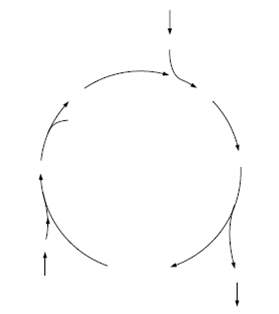Glyoxylate cycle
A number of organic acids can be used through microorganisms as carbon sources and electron donors. Those that are general to the citric acid cycle – citrate malate, fumarate and succinate for example – can be metabolized using the enzymes of the citric acid cycle. However, utilization of acetate via the citric acid cycle will cause the depletion of oxaloacetate. If this occurs the citric acid cycle could not operate. To compensate for the loss of oxaloacetate the glyoxylate shunt occurs in Figure 1.
In this pathway which shares several of the reactions of the citric acid cycle reactions that give rise to the release of CO2 are bypassed and instead isocitrate is split into succinate plus glyoxylate through the enzyme isocitrate lyase. The Succinate can be used in biosynthetic reactions while glyoxylate is combined with acetyl CoA via malate synthase to form malate which enters the citric acid cycle.

Figure 1. Glyoxylate shunt.